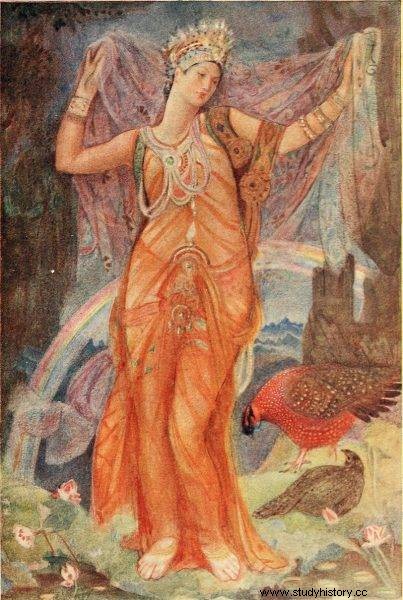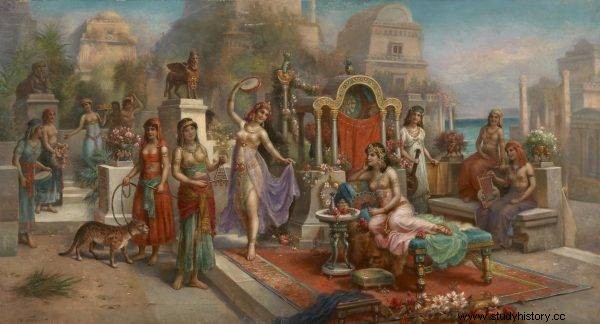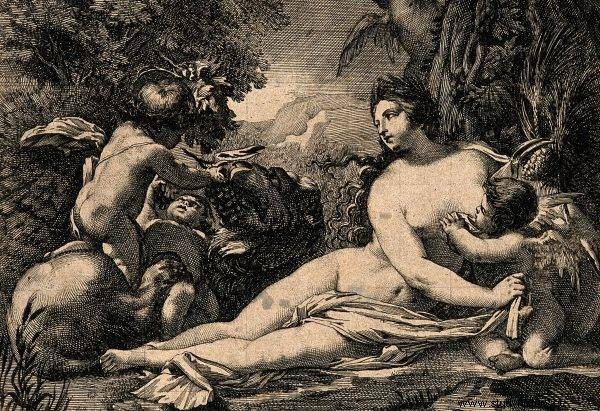The Mesopotamian capital was considered the most unbridled center of the world at that time. In Babylon, however, sex was closely related to ... religion.
Apart from the biblical Sodom and Gomorrah, there is probably no other ancient city with such a bad reputation. Of course I am talking about Babylon. The Mesopotamian capital was considered the most unbridled center of the world at that time. She was famous for "easy sex" and prostitution. There is, however, an important paradox in the whole matter. Babylonian women, yes - indulged in strangers. But was it about satisfying an exuberant drive or earning money with your own body? Not necessarily. For copulation with random partners was motivated by religious reasons.
City of Sin
Babylon was the capital of Babylon, one of the two Mesopotamian states that finally emerged after the collapse of the Sumerian-Akkadian civilization. We are talking about Assyria with the capital in Nineveh and about Babylon. Babylon on the Euphrates (near present-day Al-Hill in central Iraq, about 100 km from Baghdad) was probably founded around 2100 B.C. In the nineteenth century B.C.E. the rulers of the Amorite tribes who conquered Mesopotamia made Babylon their seat. The city gained importance in the time of King Hammurabi, the Old Babylonian period. This outstanding ruler strengthened the state, left behind a code of laws and increased the territorial area of the country.

The Mesopotamian capital was considered the most unbridled center of the world at that time.
Later, Babylonia and its capital changed hands. It was ruled by the Hittites, Kassites, Chaldeans, and Assyrians. The next period of Babylon's glory falls on the New-Babylonian dynasty, after it shed its many years of slavery to Assyria. This happened in the 7th century B.C.E. when the restored state of Babylon arose. Its first ruler was Nabopolossar. In 609, the Babylonians, united with the Medes, destroyed their oppressors. They captured and burned Nineveh, and conquered all of Assyria. It was the end of the Assyrian state and New Babylonia entered the path of rapid development.
The greatest ruler of the state was Nebuchadnezzar II. In his day, Babylon defeated the armies of Egypt, taking control of Syria and Phenicia. He also invaded Judah, captured Jerusalem, plundered the temple, and deported thousands of captives into Mesopotamia. Assyria was also incorporated into the Babylonian state. The greatest treasures and monuments of the Babylonian state come from the time of Nebuchadnezzar II. The country's capital recovered from previous hecatombs - it was expanded with many spectacular structures. It was then that the beautiful Ishtar Gate was built in honor of the Babylonian goddess, and a great pyramid-shaped Ziggurat appeared in the capital, sometimes identified with the biblical Tower of Babel.
Promiscuous goddess
Babylon's "uninteresting" reputation as a city of debauchery has been built up by the chronicle. Prostitution in the walls of the ancient city was mentioned, among others, by the chronicler Herodotus, and therefore the "father of history" . In his Histories, created after 450 BCE, wrote about temple prostitution, which was to be widespread in Babylon and mainly related to the cult of the goddess Ishtar: Every woman of this country must visit the temple of Aphrodite once in her life [Ishtar] give oneself to a stranger (...) sitting in the sacred circle of the temple (...).
Ishtar - in the later Greek world equated with Aphrodite, was the goddess of fertility. Her cult spread throughout the Middle East. Ishtar was the goddess of love and fertility, but she was associated with sex in a special way, not only the married sex, and maybe even the extra-marital sex. In the epic of Gilgamesh there is a passage in which the hero accuses the goddess of being the last one on a long list of lovers. Besides, Ishtar was the goddess of war. In mythological records, she fought side by side with her kings, and the fight was called a "playground".

It was in paying tribute to Ishtar that the women of Babylon practiced sacred prostitution
It was paying tribute to Ishtar that the women of Babylonia practiced sacred prostitution. According to Herodotus, it was the religious duty of every white-headed man to devote himself to a stranger. What's more - it was supposed to happen in the temple walls, and the chosen one was supposed to pay for the ratio!
Holy defloration
Thus, in order to fulfill their duty to the goddess, thousands of pilgrims made pilgrimages to her temple. The chronicler points out that some - what is more beautiful - women quickly fulfilled their duty to Ishtar, the less attractive ones had to wait even several years for their chance. A wanderer who visited a desert tabernacle paid the lady he had chosen to mate, but that does not mean she was taking the money for herself. These were a kind of sacrifice, a temple votum. In this way the sanctioned prostitution earned the temple and the priests themselves
The fulfillment of a sexual duty to a goddess did not involve any social stigma. The researchers of the phenomenon of sacred prostitution point out that, apart from the pilgrim women , there was also a kind of brothel at the temple of Ishtar. where the ministry was performed by priestesses , giving themselves to the faithful in exchange for a sacrifice.
Also a popular custom was the sanctioned religious defloration of teenage girls. As teens entered adulthood, they were introduced to the arcane of the art of love by ... priests who had the privilege of deflowering their fathers' daughters.
The venereal curse of Ishtar
The ancient pagan world did not condemn physical love, did not see it as a sin and a reason for shame. The sexual act was treated as an affirmation of the primal forces of nature - identified with specific deities. Historical research shows that originally, the temple prostitutes could have become sterile women . The same was true for men - male prostitution in the temples also happened.
Importantly, however, contrary to the beliefs that sometimes circulate, it was not that ancient sex was characterized by unlimited permissiveness, and the phenomenon of prostitution was in no way stigmatized. On the contrary - while "temple" sex in ancient Mesopotamia was not socially disciplined or despised, looked differently at "pure" prostitution, and thus making money with your body and sexual services. Such an act was considered degrading and, due to its "service" nature, deprived of the power, commitment and devotion that sex had of conviction and willingness.

Originally, temple prostitutes could become sterile women.
Besides, although married pilgrims who committed themselves to a stranger in the temple were not disciplined by their husbands, this does not mean that other forms of betrayal or prostitution were accepted by the spouses. Ishtar herself could bless or condemn lovers who expressed their adoration through an act of love. If the effect of having sex with a random person was, for example, festering and aching ailments - it was interpreted as a goddess' disfavor.
Sacred prostitution
Babylon is sometimes considered an ancient breeding ground for sexually transmitted diseases. Certainly, the lively casual sex contacts were conducive to spreading shameful ailments, but it is hard to say that, like prostitution itself, it was only a feature of the Babylonian state. The cult of Ishtar was spread throughout the Middle East (It also radiated other ancient cultures; in Greece and Cyprus it evolved into the cult of Aphrodite). Suffice it to say that in Assyria, adjacent to Babylon, with its beautiful capital Nineveh, the same practices took place. And Nineveh had a reputation as a city of debauchery, but only among peoples who did not accept such customs - incl. with the Israelites.

We are talking about the cult of the goddess Cybele, also popular in the Roman Empire
In fact, Babylon was not the first or the last. The phenomenon of sacred prostitution functioned in many ancient cultures around the world - incl. in Hindu India, Greece, Egypt, Mesoamerica, Phenicia, Persia, and Phrygia.
The latter featured an interesting variety of sacred prostitution, practiced by priests. I am talking about the cult of the goddess Cybele, also popular in the Roman Empire . Well - an important element of the cult was ... collective castration - in the image of Attis, the god of crops, Cybele's husband, who had cut himself off. Adepts of the priestly art during the initiation ceremony publicly mutilated themselves in private places. Later, such sterile priests (called Gauls in Rome) engaged in male prostitution. By giving themselves for money, they collected offerings for the temple and paid tribute to the goddess Cybele.
Bibliography:
- Reay Tannahill, Sex History, Book and Knowledge Publishing House 2001.
- Zdzisław Wróbel, The pleasures of a love frenzy. The Indian Art of Loving , vol. 2, Wydawnictwo Prospekt Atelier 2001.
- Andrzej Wypustek, Family life of the ancient Greeks , National Institute for them. Ossoliński 2007.
- Maarten Jozef Vermaseren, Cybele and Attis:The Myth and the Cult, Thames and Hudson 1977.
